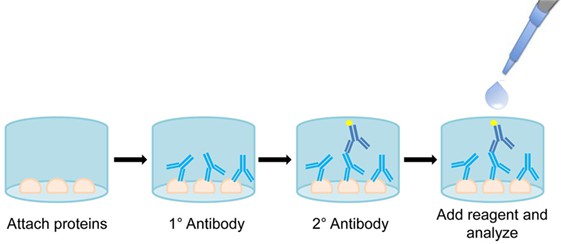Enzyme-linked Immunosorbent Assay (ELISA)
The development of antibody function analysis & characterization assays is one of the most challenging aspects for the development of therapeutic antibodies. With the years of experience in the field of antibody development and characterization, Creative Biolabs is confident in offering best-quality antibody binding assay services for worldwide customers in a timely, efficient, and low-cost manner, based on a traditional enzyme-linked immunosorbent assay (ELISA) method.
Introduction to ELISA
ELISA is a microplate-based technique commonly used for detecting peptides, proteins, antibodies, glycoproteins, and hormones in biological samples. This method was firstly described by Weiland in 1978. This technique works relying on the specific binding of antibodies to target antigens and a detection system to detect the presence of antigens. This analytical biochemistry assay has been used as a diagnostic tool in medicine, plant pathology, and biotechnology, as well as quality control in various industries.
In a direct ELISA assay, antigens are fixed to the well of 96-well (or 384-well) plate by adsorption. Then detection antibodies linked to enzymes are added and incubated with the antigens immobilized on the plate. In the final step, the enzyme substrates are added to the wells. Detection is accomplished by assessing the conjugated enzyme activity via incubation with substrates to produce a visible signal that is correlated with the amount of antigen. In addition, there have other more complicated ELISA methods (such as indirect ELISA and sandwich ELISA). In these assays, antigens may be captured on the well of the plate with a bound, antigen-specific antibody. Detection antibodies captured by antigens fixed on the plate can be detected by a secondary, enzyme-linked antibody.
 Fig. 1 Diagram of enzyme-linked immunosorbent assay (ELISA).1
Fig. 1 Diagram of enzyme-linked immunosorbent assay (ELISA).1
ELISA Method for Antibody Binding Assays
ELISA is an efficient method that is applied for detecting antibodies, peptides, and proteins in biological samples. The most key element of the ELISA detection strategy is the highly specific interaction between antibody and antigen. In other words, the highly specific antibody-antigen binding determines the success or failure in chemical analysis. As thus, ELISA is also used for antibody-antigen interaction analysis. The target antigen can be fixed on the wells of the plate. Antibody candidates coupled with enzymes are added into the plate wells. If the tested antibodies can specifically bind to the target, a visual signal will be detected by measuring the conjugated enzyme activity via incubation with a substrate. Based on this technique, we can provide a rapid and accurate method to detect and identify antibody-antigen binding.
As a leader in the field of antibody development, Creative Biolabs has accumulated a wealth of experience in antibody functional analysis. ELISA is a sensitive and specific analytical biochemistry assay commonly used for detection of antibodies and proteins, as well as for analysis of antibody-antigen binding. Backed by this powerful technique and our team of skilled experts, we are confident in offering first-in-class services. We also provide high-quality customized antibody functional assays to satisfy our customers’ unique requirements. For more detailed information, please feel free to contact us or directly sent us an inquiry.
Reference
-
Gates, Katherine V., Naveen L. Pereira, and Leigh G. Griffiths. "Cardiac non-human leukocyte antigen identification: techniques and troubles." Frontiers in Immunology 8 (2017): 1332.
Distributed under Open Access License CC BY 4.0, without modification.
For Research Use Only.
